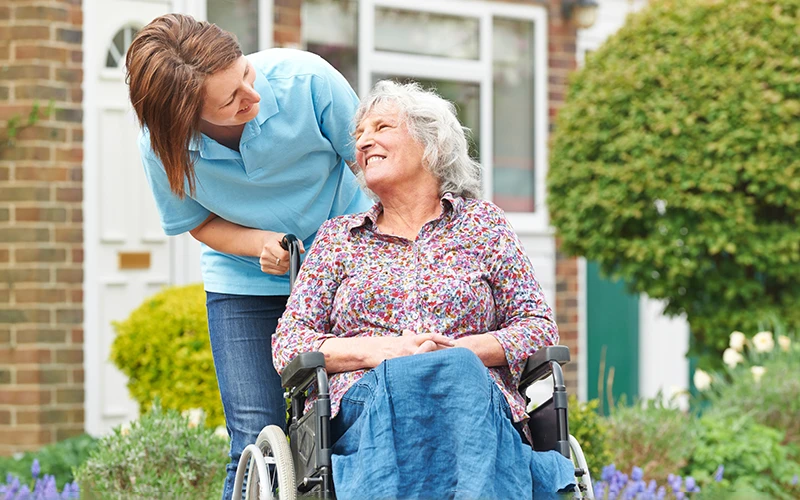From McKnights Senior Living —
A new study reporting higher mortality rates among Medicaid home- and community-based services recipients — including assisted living residents — during the pandemic compared with people not receiving those services should serve as a “huge bucket of ice water” for the senior living industry, according to one expert not affiliated with the research.
“There is still a lot we do not know,” said one of the study authors.
In a Health Affairs study published last week, investigators from the University of California San Francisco and Brandeis University provided a glimpse into the COVID-19-related deaths of people with disabilities who did not live in nursing homes.
Researchers found that for Medicaid HCBS recipients, excess mortality was 7.4 times that of other community-dwelling Medicaid beneficiaries, and 26.6 times that of the general population. Excess mortality for HCBS recipients 65 and older was slightly higher, but comparable with older nursing home residents.
The study was among the first to provide multi-state data on mortality among people receiving Medicaid HCBS during the early months of the pandemic, including residents of assisted living communities.
“We still know very little about the impacts of COVID in these settings, which really points to important policy issues related to the availability of more timely, accessible data,” Joe Caldwell, PhD, director of the Community Living Policy Center at Brandeis University and a lead author on the study, told McKnight’s Senior Living.
Although nursing homes are subject to federal reporting requirements on mortality, such reporting is not required for people receiving Medicaid HCBS. Of the 14 million people with long-term services and supports needs in the United States, the authors pointed out, only a small fraction live in nursing homes.
“Our study helps shine a light on a population that has largely been invisible in the public discourse and COVID-19 response,” the authors concluded. “Our findings highlight the vulnerability of the HCBS population during the pandemic.”
Caldwell said that he and colleagues are in the process of accessing Medicaid claims data from during the pandemic that were just recently made available. They hope to “delve into the data and learn more about mortality and the broader health impacts of COVID on individuals receiving HCBS in various settings,” he said.
“There is still a lot we do not know,” Caldwell added.
Data a window into ‘tragic consequences’ in senior living
Calling the report the “tip of the iceberg” in a tweet, Michael Wasserman, MD, past president of the California Association of Long-Term Care Medicine, said that no one knows how many residents of assisted living communities, memory care communities or group homes died from COVID-19 because no data elements exist. Looking at HCBS recipients, he said, provides a window into individuals with disabilities who have additional needs.
“This is the first attempt to begin to look at the rest of the older adult population who have died during COVID-19, to identify what their risks were, who they were, where they were, and ultimately we’ll find that we failed that population not only at the beginning of the pandemic, but specifically in the rollout of the vaccine,” Wasserman said. “It’s frustrating it’s taken this long to actually begin to uncover the tragic consequences of COVID in the senior housing space.”
Hard look at marketing needed
“To me, if you start getting into this data, it will be a huge bucket of ice water on the fact that the rest of the senior housing industry is nonmedical,” he said. “The number of deaths in this sector has been hidden in plain sight for too long.”
The senior living industry, Wasserman said, needs to take a serious look at how it markets itself as a provider of some health, well-being and medical components. Research has addressed reimagining assisted living as an affordable care option providing quality, person-centered care that melds social and medical models.
“The senior housing industry needs to ask some very uncomfortable questions about whether it’s really just housing and whether the concept that senior housing also has health, well-being and medical care attached to it is generally a myth,” he said. “I think policymakers need to look at this. I think the industry needs to look at this. I think we need to be transparent and honest.”
Significant HCBS access gaps, authors say
The University of California San Francisco and Brandeis University researchers combed through data from 14 health plans across 12 states to examine excess mortality rates for people receiving Medicaid LTSS in the form of HCBS during the pandemic.
Among the factors that likely contributed to the high mortality rates of HCBS recipients, they said, were individual risk factors, societal barriers and indirect effects. Medicaid HCBS recipients have high rates of secondary health conditions that contribute to greater risk of contracting COVID and experiencing poorer outcomes, they said. Some of those individuals also live in group settings — such as senior living — or attend congregate day programs, or they rely on daily in-person supports delivered by family or direct care workers entering their homes, increasing exposure risks.
People with disabilities, family caregivers and direct care workers in the community also faced significant barriers obtaining personal protective equipment and testing, the researchers said, and direct care worker shortages that were exacerbated during the pandemic led some people to go without essential daily supports and services.
Regardless of age group, both expected and actual mortality rates were higher for HCBS recipients than for non-HCBS Medicaid beneficiaries in the community, the authors wrote.
The pandemic elevated conversations about the need to reduce states’ reliance on nursing home care, expand access to HCBS and strengthen the direct care workforce, they said. Although states have made progress rebalancing their LTSS systems, “significant gaps” remain for HCBS access and availability, the researchers added.
“As aging and disability communities and policymakers work on systems reforms, our findings indicate a need to also address major gaps that exist in access to timely, publicly available data and quality reporting for people receiving HCBS across the age spectrum,” the authors concluded.
The study was supported by the Commonwealth Fund and the Community Living Policy Center from the National Institute on Disability, Independent Living, and Rehabilitation Research, part of the Administration for Community Living.
Continue reading at McKnightsSeniorLiving.com
Find an Elder Law or Special Needs Law Attorney

